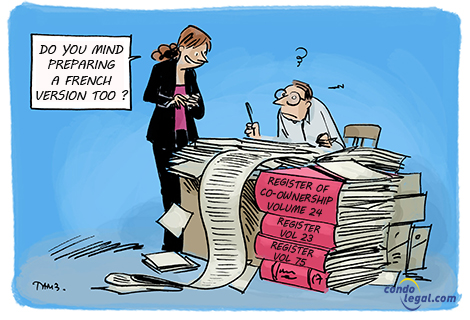
Sometimes, co-owners of contiguous private portions wish to modify the boundaries of their private portions. For example, if one of the two co-owners wishes to enlarge their apartment by incorporating part of the adjacent unit, specific procedures are necessary. Similarly, when a co-owner wishes to merge two units they own into one, important questions arise, particularly concerning the integration of common portions and the necessary steps to carry out such work. This practical guide covers the conditions and procedures required to make such modifications, while respecting the rules of the declaration of co-ownership and the Civil Code.
Modification of the boundaries of contiguous private portions
According to article 1100 of the Civil code of Quebec, co-owners of adjacent private units can modify the boundaries of their private portions units without the approval of the meeting of co-owners, provided they obtain the consent of their hypothecary creditor and the syndicate. The modification cannot result in an increase or decrease in the relative value of the modified private portions or in the voting rights attached to them. The syndicate (through the board of directors) then modifies the declaration of co-ownership and the cadastral plan at the expense of these co-owners. In this regard, the act of modification must be accompanied by the consent of the creditors, the co-owners, and the syndicate.
Mortgage loan deed
Although article 1059 of the Civil Code of Quebec does not require the signature of the mortgage creditor to modify the declaration of co-ownership, it is essential not to put the co-owners in default with their mortgage creditors, especially if the modification made to the private units results in a reduction in the area of one of them. The stipulations included in the mortgage loan agreements could put the debtor in default if an action taken diminishes the creditor's security. Article 1514 of the Civil Code of Quebec provides for the loss of the benefit of the term if a debtor reduces, by their actions and without the consent of the creditor, the securities granted to the latter.
Interpretation of contiguity
Article 1100 of the Civil Code of Quebec addresses the contiguity of private portions. This raises the question of whether these units must be separated by a common wall or a shared lot line. It is known that in a vertical co-ownership, private portions are often separated by a wall classified as a common portion, which could limit the application of this article.
The interpretation of this article is debated. A strict interpretation would lead us to consider that only private portions separated by a party wall are concerned. However, doctrine has proposed a broader interpretation, so that private portions separated by a common wall would also be covered. This interpretation, which is increasingly accepted in practice, is advantageous for the syndicate and the co-owners. Furthermore, a judgment rendered by the Superior Court of Quebec recognized that contiguity can exist even with a common wall, thus allowing the modification of the boundaries of private portions without the authorization of the meeting of co-owners in certain cases.
According to Me Christine Gagnon, in her book "La copropriété divise, 5th edition," the broad and liberal interpretation of article 1100 of the Civil Code of Quebec, which includes private portions separated by a common wall, is increasingly accepted in practice. However, this position is not unanimous and exposes the syndicate, the co-owners, and the acting notary to potential future disputes. Me Gagnon emphasizes that the application of this article may need to be determined on a case-by-case basis, depending on the common portion involved.
Merging two private portions into one: controversial subject
The Superior Court of Quebec also ruled in 2009, in the Bata case, that it is impossible to integrate an elevator lobby into two private units with restricted use. Thus, the co-owners of two adjacent units cannot, when merging these two units into one, integrate into the newly created unit an entrance hall that previously served the two distinct units without amending the declaration of co-ownership and without needing to obtain the approval of the co-owners in accordance with article 1097 of the Civil Code of Quebec.
Work requiring the meeting of co-owners’ authorization
When work is necessary to merge private portions, it may impact the common portions of the building. In this case, certain steps must be taken by the co-owner. For example, they must seek authorization from the general assembly of co-owners to carry out this work. They are also responsible for having an additional item placed on the agenda of the meeting of co-owners, specifying the nature and scope of the proposed work.
Required majorities
Such prior authorization from the meeting of co-owners must be subject to a vote, which is taken by an enhanced majority (three-quarters of the votes of co-owners present or represented at the meeting), in accordance with article 1097 of the Civil Code of Quebec. However, if the proposed work affects the destination of the immovable, for example, if the hall on a floor will no longer exist and other co-owners will no longer be able to use the corridor, this work must be subject to a vote taken by a double majority (three-quarters of the co-owners representing 90% of the votes of all co-owners), in accordance with article 1098 of the Civil Code of Quebec.
 WHAT YOU SHOULD KNOW ! Co-owners of contiguous private portions can modify the boundaries of their units without the meeting of co-owners’s consent, under certain conditions, including obtaining the mortgage creditors' and the syndicate’s consent.
WHAT YOU SHOULD KNOW ! Co-owners of contiguous private portions can modify the boundaries of their units without the meeting of co-owners’s consent, under certain conditions, including obtaining the mortgage creditors' and the syndicate’s consent.
 WHAT TO KEEP IN MIND: Merging two private portions into one requires specific steps, especially if it involves integrating common portions. The meeting of co-owners’ approval is often required in accordance with article 1097 of the Civil Code of Quebec.
WHAT TO KEEP IN MIND: Merging two private portions into one requires specific steps, especially if it involves integrating common portions. The meeting of co-owners’ approval is often required in accordance with article 1097 of the Civil Code of Quebec.
 WARNING ! Modifying private portions by integrating common portions, such as an entrance hall, without amending the declaration of co-ownership or the meeting of co-owners’s consent, can lead to legal disputes.
WARNING ! Modifying private portions by integrating common portions, such as an entrance hall, without amending the declaration of co-ownership or the meeting of co-owners’s consent, can lead to legal disputes.






